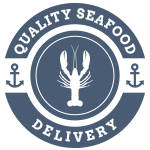Ordering food online is more common than ever, but you might not know what to expect when seafood is shipped to your door. Seafood shipping is a large, often complicated process composed of several moving parts. What’s more, each company and distributor have a unique process, making it difficult to anticipate exactly how fish get from the docks to your doorstep. That said, there are a lot of industry-wide standards. Below, we’ve outlined a few key factors that come into play during seafood shipping, regardless of what type of product you want to order.
Breaking Down Shipping Costs
Seafood shipping can seem expensive, but those costs exist for a reason. Seafood is often shipped frozen or live, which means products must be delivered quickly to maintain quality. Live lobster shipment, for example, is often only available as an overnight delivery. The longer the animal is out of the water, the more likely it is to perish in transit. A similar principle applies to frozen seafood; while the packaging keeps products cool, ice packs can only stay cold for a day or two. As a result, shipping costs are likely to be more than an average food delivery.
However, it is important to understand that the cost of shipping will not always reflect the quality of the seafood product. In some cases, companies pre-configure their price models to account for the added cost of overnight or 2-day delivery, especially if you are ordering whole, live lobster. Depending on your proximity to the origin location, shipping costs don’t vary much across the industry. The only factor affecting your perception of the cost is whether it is factored into the per-pound price of the seafood.
How Seafood is Shipped: Packaging Protocols
Time is the biggest hurdle for fish and lobster providers during seafood shipping. While overnight delivery shortens the timeline, the companies themselves need to package products to ensure a safe and secure delivery. Often, this means shipping seafood in coolers with ice packs.
Seafood shipping packaging is pretty standard across the industry. Most shipments are packed in Styrofoam containers with several cool packs to maintain a safe internal temperature. Live lobster shipping containers are typically larger than frozen seafood coolers. This provides the animals with a slightly more comfortable environment during their short journey.
While these coolers can stay cold for the shipping process, they will not stay cool indefinitely. When your package arrives, put your products in the freezer or refrigerator. Cool packs and Styrofoam coolers are often reusable, so hang onto them for your next camping trip or long drive.
What to Expect from Online Seafood Shipping
Before your shipment arrives, take a moment to assess the storage space available in your freezer or refrigerator. Most customer order frozen seafood in bulk, which means you’ll want to ensure you have a place to store your purchase as soon as it arrives. As we’ve mentioned, the Styrofoam containers used for shipping will keep the products frozen, but not for very long. Ask yourself: Do I have enough room in the freezer to store salmon for a few months? Can you go without most of my freezing space for a few hours before cooking the lobster? Do I have a pot big enough to cook them in? You’ll want to have answers to these questions before your seafood shipment arrives.
Notably, you should try to be home when your seafood shipment arrives. This is especially important if you are ordering live lobster. If you cannot be at home to accept the package, leave a note for the delivery person to leave it in a secured, shaded area, or consider picking it up at a delivery facility or airport.
Fresh and Frozen Seafood for Sale with Shipping
Shipping infrastructure has improved exponentially in the past few years, which means nearly every type of seafood is available for overnight or rush delivery. However, a few products are more popular than others. If you’re interested in having lobster, salmon, or other types of fish shipped to your door, check out our helpful guides.
- Lobster: When buying lobster online, you will choose between parts (tails and claws in shells), meat, and whole, live lobsters. For live lobsters, the per-pound price will vary depending on the shipping and handling costs. Schedule your live lobster shipment and delivery carefully so that you can be at home to receive the package.
- Salmon: Buying salmon online is easy, but knowing what to look for can be difficult. There is no easy, definitive answer when it comes to understanding salmon shipping costs, but per-pound price differences often depend on the size of your order and the capabilities of your fishery. In general, you should expect to pay between $5-$7 per pound for a single batch of frozen salmon, $7-$8 per pound for smaller orders that just barely meet the minimum order size, and between $2-$4 pounds for commercial fishers who process thousands of pounds of the fish. If you’re interested in learning more about salmon shipping, check out our salmon shipping guide.
- Other Seafood: While salmon and lobster might be more popular seafood items to ship across the country, there are other options, too. Most shipped seafood will come frozen and filleted, but some retailers provide whole fish that have been flash-frozen and mollusks that have been cooked. Price will vary based on shipping distance, your order size, and your retailer.
Take note of our Affiliate Relationships that may exist with this page and companies listed on it.

